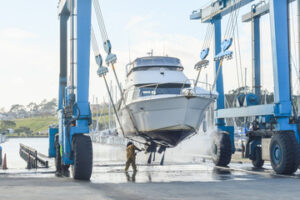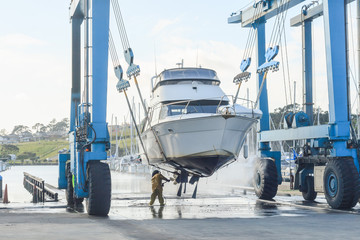Owning a boat is an expensive investment, but a boat lift makes storing and retrieving your water vessel much more convenient. It also helps protect your boat from damage caused by weather, algae growth, and corrosion.
When choosing a boat lift, consider the weight capacity. Often, more strength is needed in rough water locations or if you have passengers on board.
A boat lift is designed to lift your boat out of the water when not in use and allow you to keep it docked without being set in the water. This prevents damage to your boat and reduces environmental damage from algae, barnacles, and other marine growth. It also makes it easy to access your boat for maintenance and repair, reducing the time spent cleaning and scrubbing algae from hulls or removing corrosion from metal boats. This protects your investment and extends the life of your boat.
Many customers who have a lift say it has saved them money in boat repairs and reduced their maintenance costs by keeping their boat above the water and out of the elements. By preventing the build-up of algae, barnacles and other marine debris, you can spend more time on water adventures instead of cleaning and maintaining your boat.
Leaving your boat in the water can lead to significant damage from rough waters, tide changes and flood debris. Rough weather can also cause scrapes and scuffs on the boat and dock. A boat lift is an effective way to protect your investment and increase the value of your property.
Boat lifts are also a great way to protect your boat from thieves. Because your boat isn’t constantly in the water, it can be harder for potential thieves to see your boat when it’s sitting up on the lift. Additionally, a lift can help to protect your boat from vandalism and other types of crime by making it less accessible.
There are some things you can do to keep your boat lift in good condition, including regularly inspecting the lift and lubricating it. In addition, it is important to adhere to the recommended weight capacity for your boat lift to ensure that it works properly.
You should also make sure that the bunks where your boat sits on the lift are in good condition. Check for any rust or loose screws, and ensure that they are tightened. Regularly checking your bunks will help to prevent them from becoming dislodged or damaged by high winds. Adding straps around your boat will also help to keep it in place when the lift is in operation and will protect both the boat and the lift from damage during storms.
Keeps Your Boat in the Water
Using a boat lift means that you can keep your boat in the water all season long. This eliminates the need to trailer your boat, which saves you time and money.
A boat lift can also help you avoid costly maintenance issues that can happen when a boat sits in the water all year. For example, algae can grow on a boat that is docked in the water all year, which leads to corrosion. This can cost you a lot of money in repairs or even in replacing your boat. But if your boat is always above the waterline, algae will not be able to grow and you won’t have to deal with this issue.
In addition, it’s easy to get on and off of a boat that is always at dock level. This is much easier than trying to climb on and off a boat that’s wet stored and fluctuates in height during changes in the water. It’s also safer for people to get on and off the boat when it’s not surrounded by waves or other floating debris.
There are many different types of boat lifts on the market, so it’s important to select the right one for your needs and location. Consider your boat’s size and weight, as well as the water depth where you live. Different lifts have different capacities, and you’ll want to make sure that your boat can fit on the lift when it’s at full capacity.
If you live in a rough water location where waves crash or the water is generally faster and more turbulent, look for a heavier-duty lift that has stronger arms, mechanisms, bolts and bushings to withstand more wear and tear. Additionally, you’ll want to look for a lift that has a longer cradle that can support the entire length of your boat.
You can even choose a hydraulic lift for your boat, which is more energy efficient and gets your boat out of the water in less time than manual lifts. This type of lift is perfect for inland lakes or rivers, and it can be used in situations where there’s limited waterfront space.
Increases Property Values
A boat lift is a great investment for any waterfront property owner. It provides added convenience, protection, and aesthetic appeal to your property while also increasing its value. The best part is that a boat lift can work with any type of dock, including floating docks! This is perfect for homeowners with deeper water or a bed that would make traditional dock installation more difficult.
Whether you are just starting out or looking to upgrade your current boat dock, you will be amazed at how much more time and money a boat lift will save you. Not only will it help keep your boat safe and secure while not in use, but it will also prevent costly repairs and extend the life of your boat.
There are many different types of boat lifts available on the market, so it is important to choose one that fits your needs and budget. It is also crucial to consider your waterfront conditions and boat size when choosing a boat lift. Floating boat lifts are becoming increasingly popular, as they can be used on any type of floating dock. They are also great for homes with deep water or a sandy bed, and they offer a more natural look than traditional docks.
Another new boat lift is the piling mount lift, which is attached directly to a fixed dock or pilings. This type of lift is ideal for homeowners with limited space or a shallow water depth, and it can be installed on wood pilings or concrete. Piling mount lifts are also easy to maintain and can be very affordable.
The Hernando Beach South boat lift was a hot topic at Tuesday night’s public hearing, as residents voiced their frustration with the county over the $12 monthly fee they will now pay to use the lift. But County Commissioner Bob Gagne pointed out that the boat lift will also help to increase property values in the Hernando Beach South area, and that it should be seen as a positive rather than a negative. Larry Doyle, president of the Hernando Beach Property Owners Association, agreed, saying that he believes the indirect access to the water that the lift provides will increase property values by $5,000 to $10,000.
Saves You Time
Leaving your boat tied at the dock increases the risk of damage and watercraft theft. A boat lift eliminates the need to tie your boat up at a private dock or marina and saves you time by not having to transport your vessel after each use. It also prevents the need to continuously re-tie your boat bumpers and dock lines. Additionally, a boat lift keeps your boat above the surface, which is less susceptible to marine growth and allows you to skip applying bottom paint to your boat every year.
Depending on where you live, your body of water experiences fluctuating water levels due to storms and seasons. A boat lift is a great investment for any home in an area with fluctuating water levels because it can keep your boat safe from damaging debris that might be in the waters or smashed against the dock during storms.
The best type of boat lift for a lake or river with a fluctuating water level is a floating one. These types of lifts are easy to move, assemble and operate since they are electrically powered and have an adjustable range of capabilities. Floating lifts are also a good choice for shorelines with delicate bottoms since they have little to no impact on the sediment beneath them.
If you have a calm location on a body of water, you can opt for a piling mount or 4-post conventional lift. These lifts are strong and durable against the elements, making them a great choice for areas with harsh weather. They are easily operated with the push of a button or turn of a key, so they can be used by anyone without difficulty.
Getting your boat off and on the lift is simple and convenient with hydraulic lifts. They work like an elevator, so you just need to push the control button or turn off a key to lower your boat and raise it back up. Hydraulic lifts are also energy efficient so that they won’t waste your money on electricity. The most important thing to remember when choosing a hydraulic lift is to check the weight capacity of your vessel to ensure it will be suitable for the model you choose.


 During the off-season, dock owners can contact a professional to fix their dock.
During the off-season, dock owners can contact a professional to fix their dock.